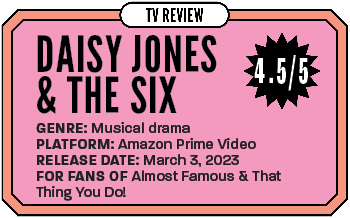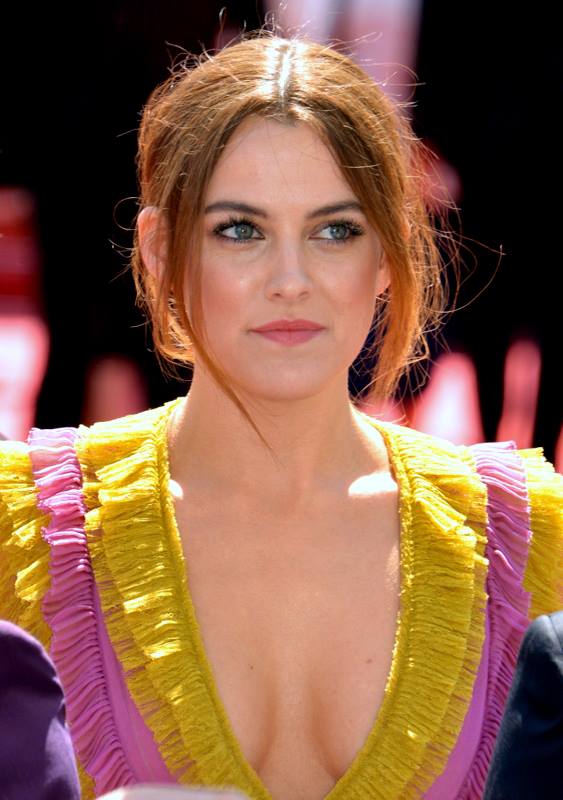Review: ‘Daisy Jones & the Six’: An unregrettable watch


Let’s set the record straight: Daisy Jones & the Six is a fictional band, but they’re dominating real-world charts. It’s what makes for the unique viewing experience that is the rock ‘n’ roll odyssey “Daisy Jones & the Six,” Amazon’s ten-episode miniseries adapted from the namesake novel by Taylor Jenkins Reid. Part docu-style, part narrative drama, topped off with a companion album “Aurora” stacked with genuinely good songs cover to cover, “Daisy Jones & the Six” feels more real than it doesn’t.
Conceptually, Reid’s novel demanded itself to be made into something visual and audible. The novel includes a full length catalog of “Aurora” lyrics, and the book cover — a young woman’s face lost in a hurricane of ginger curls — begs the question: Who is this girl? For fans of the book, the series devotes itself to maintaining a considerable degree of accuracy to its source material — well, except that the aforementioned “Six” is moreso “the Five,” hence a missing band member, but there’s a sweet workaround. Despite some major changes, Amazon’s adaption doesn’t hinder its predecessor; it lives up to it, enhancing a story that was always meant to be taken off the page.
Twenty years following the group’s final performance, the estranged band members are gathered for a tell-all documentary to give their accounts of the group’s rise to fame in the 1970’s rock scene, the monumental recording sessions behind “Aurora” and to reveal the details of their split. The band’s history is mainly framed around the explosive feud between lead singers Daisy Jones (Riley Keough) and Billy Dunne (Sam Claflin), but as other members chime in, the backstage drama proves more eventful than just their quarrels.
Backing up Dunne and Jones is the loveable ensemble that includes lead guitarist Graham Dunne (Will Harrison), keyboardist Karen Sirko (Suki Waterhouse), bassist Eddie Roundtree (Josh Whitehouse), drummer Warren Rojas (Sebastian Chacon) and Camilla Dunne (Camila Moronne), wife to Billy and the band’s key non-musical member. In switching back and forth between their younger and wiser selves, the show cultivates an intimately authentic look at the band that makes them feel more human than mythological.
“Daisy Jones & the Six” lends itself to the Mount Rushmore of rock legends, taking clear inspiration from the inter-band dynamics of Fleetwood Mac. The rock ‘n’ roll mythos does come with the cost of its tropes, caricatures and appetite for nostalgia, but “Daisy Jones & the Six” still manages to find its legs with an original story while paying tribute to the seventies zeitgeist.

The series does more than just reflect on the dreamland that was the Los Angeles music scene, but takes viewers to where it all really happened — from the Whiskey a Go Go to Sound City — and enhances these places with glamorous production design, costumes and hair and makeup to fully realize a world many can only imagine experiencing. The atmosphere runs deep in the lyricism of “Aurora,” and it truly comes to life through its perfectly casted ensemble.
The show’s biggest success is Keough’s outstanding performance as Daisy Jones, a role that might as well have been made for the actress, whose scrappy demeanor harmonizes perfectly with Claflin’s gritty charm. But it’s Morrone’s graceful performance as Camila Dunne that is the beating heart of the show — and easily breaks the heart. While the other “Six” actors could have been spared more time to explore their characters in the earlier episodes, they each make memorable impressions by the series finale to complete the picture.
The series kicks off before Daisy Jones and the members of the Six were joined by the “&” in their name. In the late ‘60s, Daisy Jones is a neglected teen finding her voice on the psychedelic Sunset Strip, but finds herself being creatively taken advantage of. She closes herself off to the prospect of performing, but with the encouragement of her ride-or-die best friend Simone Jackson (Nabiyah Be), a fellow musician and rising disco star, Daisy begins to realize her own creative potential.
In Pittsburg, brothers Billy and Graham Dunne play casual gigs with their friends, including future “Six” members Eddie and Warren, as “The Dunne Brothers.” They’re a local hit, and following a chance encounter with band manager Rod Reyes (Timothy Olyphant), they look West to the bustling L.A. rock scene to chase their dreams. But the spark that really ignites the passion behind the music is the young love of Billy and Camila, who decide to hit the road together.
Despite his undying devotion to his wife, Billy’s struggle with drinking and the inebriety of a rocker persona is just the first trial of their relationship. So when the free-spirited Daisy later enters the picture, Billy’s commitment to becoming a better person is put under even greater pressure. Keough and Claflin have a searing chemistry that embodies a suppressed temptation — not just for the intoxication of drugs and alcohol, but for each other.
In the unforgiving world of rock ‘n’ roll, the musicians’ lives prove to be as delicate as their art. “Daisy Jones & the Six” understands that fame and relevance are mortal instruments, so it makes the most of what plays out to be a tragically short-lived affair. The music will never die, but what lingers most after Daisy Jones & the Six exit the building is an unforgettable story about a band that can say they really did it all.

